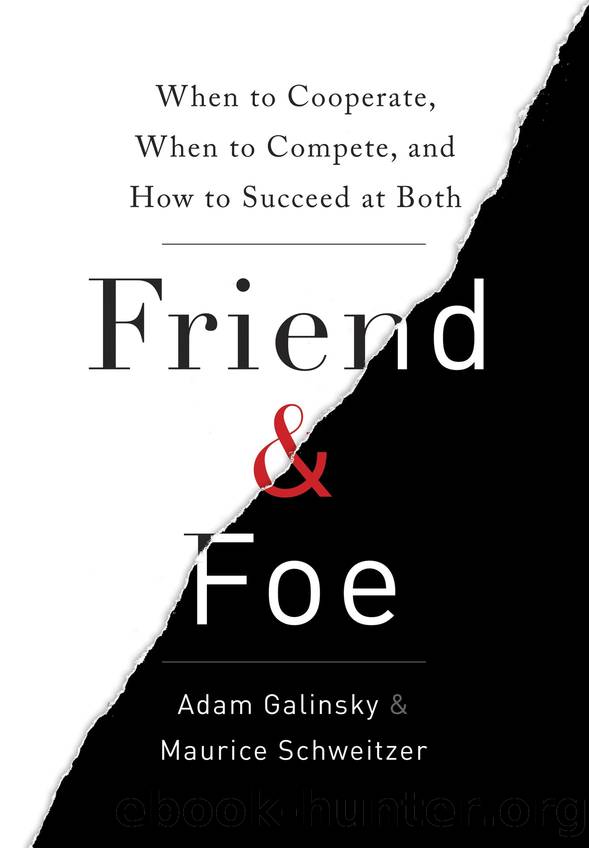Friend & Foe by Adam Galinsky

Author:Adam Galinsky [Schweitzer, Maurice]
Language: eng
Format: epub
Publisher: The Crown Publishing Group
Published: 2015-09-29T00:00:00+00:00
Why Happy Families Produce Terrorists
Omar Hammami was raised in rural Alabama. The son of a Syrian immigrant and an Alabama native, he grew up in a loving family. He played soccer, he was close with his sister and parents, and he regularly visited his grandparents’ farm, where he enjoyed lazy afternoons shelling peas and eating watermelon.
And at school, Omar was popular—very popular. He was the president of his sophomore class, he was always surrounded by friends, and he dated one of the most popular girls.
So how did someone like Omar come to join an Islamist rebel group known for beheadings, stoning people to death, and chopping off people’s hands? According to Robert Pape of the University of Chicago, his transition from class president to foreign jihadist reflected “an altruism gone wildly wrong.” Though Omar had attended Bible camp and church growing up, in his adolescence he found meaning in his Muslim roots. He began to identify as a Muslim, and it was through this prism that he viewed the invasion of Iraq and the events in Somalia with alarm. Despite having grown up in America, when Muslims in Iraq and Somalia were attacked, he identified with them so strongly that he was moved to act.
In contrast to the belief that terrorists are isolated loners, most terrorists were raised just like Omar—in caring families surrounded by friends. When the British Security Service, MI5, interviewed convicted terrorists and conducted long-term surveillance of terrorists, they found that most terrorists grew up in loving families and had lots of friends. In fact, fully 90 percent of the terrorists MI5 interviewed were characterized as “sociable.”
The MI5 findings are completely consistent with former CIA operations officer Marc Sageman’s research. As a foreign service officer, Marc worked with Islamic fundamentalists during the Afghan-Soviet war and studied terrorism extensively after he returned to the United States. Similar to the MI5 conclusions, he found that terrorists tend to come from middle-class, educated, religious, and supportive families. These individuals care deeply about their community, but begin to see outsiders as a threat.
And this is why it is sometimes the friendliest people within a group who come to see members of other groups as foes.
To succeed in our social world—whether in business, in our relationships, or in any other area of our lives—we cooperate within our group in order to compete effectively against other groups. Often, this means looking out for—and trusting—members of our own group, and distrusting members of other groups.
But how we define “our” group is often fluid. Across scores of studies of groups, two key results keep emerging. First, it is surprisingly easy for us to define ourselves as part of a group. Consider experiments where complete strangers are randomly assigned to either a “red” team or a “blue” team. It only takes a few moments before each team starts adopting favorable impressions of their teammates…and hostile views of the other team members. If we are assigned to the red team, we cooperate with other “reds” but compete against the “blues.
Download
This site does not store any files on its server. We only index and link to content provided by other sites. Please contact the content providers to delete copyright contents if any and email us, we'll remove relevant links or contents immediately.
The Art of Thinking Clearly by Rolf Dobelli(10310)
Mindhunter: Inside the FBI's Elite Serial Crime Unit by John E. Douglas & Mark Olshaker(9259)
Change Your Questions, Change Your Life by Marilee Adams(7676)
Nudge - Improving Decisions about Health, Wealth, and Happiness by Thaler Sunstein(7654)
Mastermind: How to Think Like Sherlock Holmes by Maria Konnikova(7274)
The Power of Now: A Guide to Spiritual Enlightenment by Eckhart Tolle(5674)
Men In Love by Nancy Friday(5192)
Altered Sensations by David Pantalony(5071)
Factfulness: Ten Reasons We're Wrong About the World – and Why Things Are Better Than You Think by Hans Rosling(4710)
The Confidence Code by Katty Kay(4215)
Thinking in Bets by Annie Duke(4182)
Man and His Symbols by Carl Gustav Jung(4092)
The Worm at the Core by Sheldon Solomon(3450)
Why Buddhism is True by Robert Wright(3423)
Liar's Poker by Michael Lewis(3411)
Three Women by Lisa Taddeo(3388)
The Inner Life of Animals by Peter Wohlleben(3282)
Descartes' Error by Antonio Damasio(3247)
How Music Works by David Byrne(3232)
